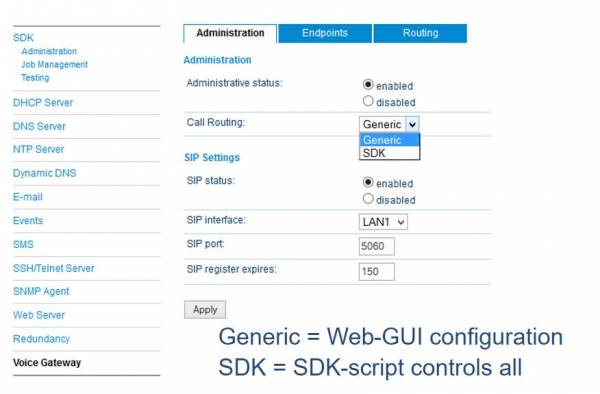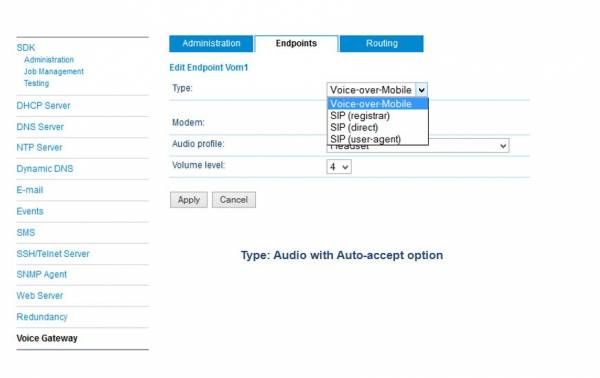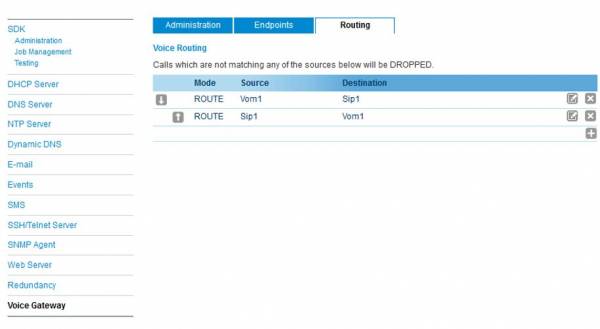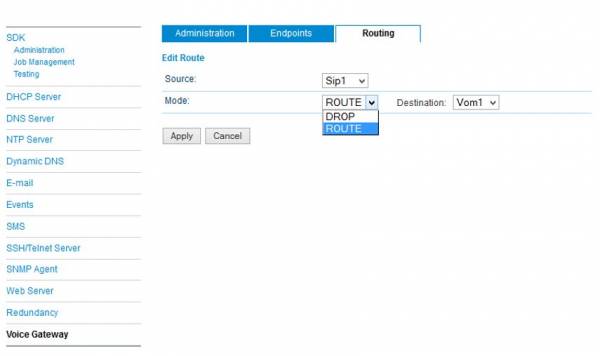User Tools
Site Tools
This is an old revision of the document!
Table of Contents
Voice support
The NetModule Router Series NB2000 and NB3000 support voice and audio communication with two extension:
- Voice GSM-Voice to VoIP/SIP to make or receive voice call over the mobile network.
- Audio line-in/out to VoIP/SIP to connect audio signals directly to the device. Typical microphone and loudspeaker via external amplifier.
Basic concept
An endpoint is a SIP/VoIP device like
- Internal GSM-Voice
- Internal Audio-Interface
- External SIP-Phone, PBX, door station etc.
To establish a call two steps are needed:
- Signalling = establish a call
- Call-Routing = making the connection
Simple behaviour can be configured by the Web-GUI. For more complex applications the SDK can be used.
Voice gateway configuration via Web GUI
Administration
Endpoints
Endpoint types
Routing
Routing modes
SDK scripts
Endpoints are represented as structs
struct(3): {
.id = int: 54321
.desc = string[5]: "vom://Vom1"
.state = string[4]: "busy"
.volume = = int: 7
};
Descriptors
- Sip1 First SIP subscriber
- Vom1 First Voice-Over-Mobile
- Aud1 First Audio device
- sip:⁄⁄user@192 .168.1.254:5060 SIP address
States
- busy endpoint is already holding a call
- available endpoint is ready to take a call
Calls are represented as structures which may look like:
struct(5): {
.id = int: 12345
.state = string[7]: "dialing"
.calling = string[24]: "sip://user@192 .168.1.254:5060"
.called = string[22]: "vom://+123456789 @Vom1"
};
The following states are possible:
- routing call is in routing state
- dialing call is in dialing state
- alerting call is in alerting state
- active call is active
- hungup call had hung up
Voice functions:
- array nb_voice_endpoint_list (void) / struct nb_voice_endpoint_get (endpoint)
- Unordered List Itemarray nb_voice_call_list (void) / struct nb_voice_call_get (call)
- int nb_voice_call_dial (call)
- int nb_voice_call_accept (call)
- int nb_voice_call_route (call, endpoint)
- int nb_voice_call_hangup (call)
- int nb_voice_call_volume (endpoint, int level)
How to make a call
Start Call
- Unordered List Itemnb_voice_call_dial(call) or wait for call
Event magement
- Unordered List ItemOutgoing – do nothing
- Incomming - nb_voice_call_route(call, target endpoint)
- Dispatched: alerting → nb_voice_call_accept(call)
End Call
- nb_voice_call_hangup(call)






